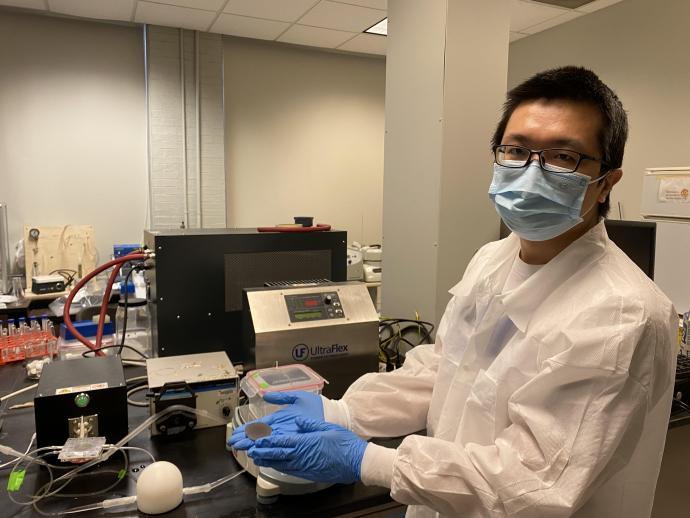Three NJIT Engineering Teams Showcase Their Research at the EPA's National Student Design Expo

Three teams of student engineers are showcasing their applied research this week at the U.S. Environmental Protection Agency’s National Student Design Expo, as they vie for a second round of funding from the EPA’s People, Prosperity and the Planet program, which aims to spur new systems and technologies that advance sustainability.
“Despite the challenges of last year, you worked hard, you thought creatively and you developed innovative solutions that support EPA’s mission to protect human health and the environment,” said Janet McCabe, deputy administrator of the EPA, in opening remarks to students at the virtual expo. “Many of your projects have the potential to help tackle climate change, to protect our drinking water and to advance environmental justice.”
Each of the three NJIT teams received phase-1 awards of $25,000 last year to develop ideas to solve difficult environmental remediation problems affecting soil and water. They are now competing for phase-2 awards of $100,000. The NJIT projects are:
Microwave-Catalytic Membrane for PFAS Degradation
Project advisor: Wen Zhang, associate professor of environmental engineering
Project Lead: Fangzhou Liu, Ph.D. candidate
Master’s students: Krishna Cherith Kollippara Venkata Sai and Courtney Potts
Undergraduate students: Jeffrey Luke, Samuel Solomon, Ashish Kokkula and Humza Abdali
The team is developing a novel microwave-assisted membrane filtration system that combines microwave catalysis and microfiltration to enhance the breakdown and removal from water of PFOA and PFOS, both of which are Per- and Poly-fluoroalkyl Substances or PFAS, degradation-resistant, toxic chemicals with strong carbon-fluorine bonds that are used to make industrial and commercial coatings. A central element of their approach is the use of membranes coated with microwave-responsive catalysts that can target PFAS with fast, non-contact, directed energy. In the future, the team plans to test the functionalized membranes as anti-bacterial and anti-viral devices.
“Our goal is to increase degradation efficiency and to use microwaves safely in the open air,” explains Liu.
Induction-Surface-Heating Membrane Distillation
Project advisor: Wen Zhang, associate professor of environmental engineering
Project lead: Weihua Qing, postdoctoral research fellow
Master’s student: Indrayani Thakare
Undergraduate students: Luke Galan and Adam Nickelston
In order to create potable water from sea water efficiently, the team is developing an innovative induction-heating-assisted membrane desalination system that uses electromagnetic induction energy to locally heat the membrane/liquid interface to power salty water vaporization and transportation in membrane distillation processes. One of the technical challenges is to synthesize induction-responsive nanoparticles and conductive polymers and to incorporate them onto conventional hydrophobic membranes to maximize the absorption and conversion of electromagnetic induction energy into thermal energy.
“With conventional membrane distillation, you need to heat the entire bulk feed of sea water, which along with the necessary apparatus, is very costly,” explained Qing (below). “We’re trying to create a system that uses magnetic induction, rather than an external heating source, to heat the water just at the membrane interface.”
Remediation of PFAS Contaminated Soils and Sediments
Project advisor: Jay Meegoda, professor of environmental engineering, and Lucia Rodriguez-Freire, assistant professor of environmental engineering
Project lead: Jitendra Kewalramani, Ph.D. candidate
Ph.D. student: Boran Wang
Undergraduate students: Richard Marsh and Brian McGlew
The team is developing a novel system that uses ultrasound to treat PFAS in the soil, where the toxic, bio-accumulative chemicals are persistent and pose a threat to groundwater and surface water. To date, there are no proven methods to treat them in soil in a cost-effective, environmentally-friendly and energy-efficient manner. They are exploring the feasibility of using a novel ultrasound device to degrade them. It combines two different ultrasonic technologies to produce an intense ultrasonic field: a horn (or probe) type low-frequency transducer that stirs up solids through agitation, detaching contaminants from the surface of solids, and a submersible (or plate) type high-frequency transducer that initiates the sonochemical degradation of pollutants through pyrolysis and radical reactions.
“Most PFAS remediation is focused on water, not soil,” noted Kewalramani. “Our device is one of the first of its kind to treat soil with ultrasound.”


